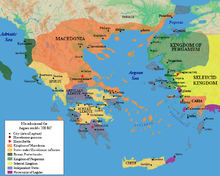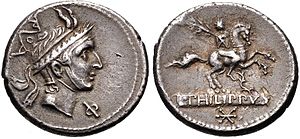Philip V of Macedon
This article includes a list of general references, but it remains largely unverified because it lacks sufficient corresponding inline citations. (February 2010) |
| Philip V | |
|---|---|
 Didrachm of Philip V of Macedon | |
| Basileus of Macedonia | |
| Reign | 221–179 BC |
| Predecessor | Antigonus III Doson |
| Successor | Perseus |
| Born | 238 BC Pella, Macedonia |
| Died | 179 BC (aged 59) Amphipolis, Macedonia |
| Spouse | Polycratia |
| Issue | Perseus Apame IV Demetrius Philippus |
| Greek | Φίλιππος (Philippos) |
| House | Antigonid dynasty |
| Father | Demetrius II Aetolicus |
| Mother | Chryseis |
Philip V (Greek: Φίλιππος Philippos; 238–179 BC) was king (Basileus) of the ancient Kingdom of Macedonia from 221 to 179 BC. Philip's reign was principally marked by an unsuccessful struggle with the emerging power of the Roman Republic. He would lead Macedon against Rome in the First and Second Macedonian Wars, losing the latter but allying with Rome in the Roman-Seleucid War towards the end of his reign.
Early life[]
Philip was the son of Demetrius II of Macedon and Chryseis. Philip was nine years old when his father died 229 BC. His elder paternal half sister was Apama III.[1] Philips's great-uncle, Antigonus III Doson, administered the kingdom as regent until his death in 221 BC when Philip was seventeen years old.[citation needed]
Philip was attractive and charismatic as a young man. A dashing and courageous warrior, he was inevitably compared to Alexander the Great and was nicknamed beloved of the Hellenes (ἐρώμενος τῶν Ἑλλήνων) because he became, as Polybius put it, "...the beloved of the Hellenes for his charitable inclination".[2]
After ascending to the throne, Philip V in the first year of his reign pushed back the Dardani and other tribes in the north of Macedonia.[citation needed]
The Social War[]

The Social War (220–217 BC) started, when the Hellenic League of Greek city states was assembled in Corinth at the instigation of Philip V. He led the Hellenic League in battles against Aetolia, Sparta and Elis. In doing so, Philip V was able to increase his own authority amongst his own ministers. His leadership during the Social War made him well known and respected within his own kingdom and abroad.[citation needed]
First Macedonian War (214–205 BC)[]


After the Peace of Naupactus in 217 BC, Philip V tried to replace Roman influence along the eastern shore of the Adriatic Sea, forming alliances or lending patronage to certain island and coastal provinces such as Lato on Crete. He first tried to invade Illyria from the sea, but with limited success. His first expedition in 216 BC had to be aborted, while he suffered the loss of his whole fleet in a second expedition in 214 BC. A later expedition by land met with greater success when he captured Lissus in 212 BC.[3][4]
In 215 BC Philip V signed the Macedonian–Carthaginian Treaty with Hannibal the Carthaginian general. Their treaty defined spheres of operation and interest, but achieved little of substance or value for either side. Philip V became heavily involved in assisting and protecting his allies from attacks from the Spartans, the Romans and their allies.
Rome's alliance with the Aetolian League in 211 BC effectively neutralised Philip's advantage on land. The intervention of Attalus I of Pergamum on the Roman side further exposed Philip's position in Macedonia. Philip was able to take advantage of the withdrawal of Attalus from the Greek mainland in 207 BC, along with Roman inactivity and the increasing role of Philopoemen, the strategos of the Achaean League. Philip and his troops sacked Thermum, the religious and political centre of Aetolia. His troops destroyed 2,000 statues and hauled away vast sums of treasure which included some fifteen thousand shields and suits of arms the Aetolians had decorated their stoas with. These shields were the armor taken from the enemies of the Aetolians during their previous military victories and included the shields of the Gauls who had raided Greece in the 3rd century BC.[5]
Philip V took immense sums of gold and treasures and then burned down temples and public buildings of the Aetolians.[6] Philip was able to force the Aetolians to accept his terms in 206 BC. The following year he was able to conclude the Peace of Phoenice with Rome and its allies.[citation needed]
Expansion in the Aegean[]
Following an agreement with the Seleucid king Antiochus III to capture Egyptian held territory from the boy king Ptolemy V, Philip was able to gain control of Egyptian territory in the Aegean Sea and in Anatolia. This expansion of Macedonian influence created alarm in a number of neighbouring states, including Pergamum and Rhodes. Their navies clashed with Philip’s off Chios and Lade (near Miletus) in 201 BC. At around the same time, the Romans were finally the victors over Carthage.
Second Macedonian War[]

In 200 BC Philip V intended to invade Egypt and his troops assaulted Abydos.[7] In response, Roman troops were moved to Apollonia. The state of war was reached because the Roman Senate regarded Philip V as a dangerous lunatic.[8] Despite a decade of war, Philip V was determined to establish control over Greece. After negotiations Philip V in 200 BC established a formal alliance with Antiochus III the Great, who ruled the Seleucid empire. At this point, Rome formally declared war against Macedonia. The Second Macedonian War formally ended in 196 BC, after Philip V was defeated by the Roman army in the Battle of Cynoscephalae.[9]
Peace treaty with Rome[]
In 196 BC Philip V signed a peace treaty with the Romans. As per the treaty, Philip V could no longer harvest timber on the territory under his control. This effectively meant he could not build up an arsenal of weapons, such as large naval vessels.[10]
Following the peace treaty, Philip cooperated with the Romans and provided material support for their wars against the Spartans under Nabis in 195 BC. Philip V also supported the Romans against Antiochus III the Great and the Aetolian League.[11] After the Roman–Seleucid War the Romans allowed Philip V to keep territory he had conquered, such as Demetrias, the Magnesian coastline of Thessaly, parts of Athamania, parts of Dolopia, parts of Perrhaebia, and a number of towns in the Malian Gulf.[12]
Internal reforms[]

Philip V was able to generate revenue by imposing taxes on the population of Macedonia and the exploitation of royal property, including mining, forestry and agriculture. According to the Roman historian Livy, less than half of the tributum paid to Philip V was passed on to Rome after 168 BC. Following the Second Macedonian War, Philip V increased his revenues from agriculture and mines.[14] Philip focused on consolidating power within Macedonia. He reorganised the country's internal affairs and finances. Mines were reopened, and a new currency was minted.[citation needed]
Final years[]
However, Rome continued to be suspicious of Philip's intentions. Accusations by Macedon's neighboring states, particularly Pergamon, led to constant interference from Rome. Feeling the threat growing that Rome would invade Macedon and remove him as king, he tried to extend his influence in the Balkans by force and diplomacy. However, his efforts were undermined by the pro-Roman policy of his younger son Demetrius, who was encouraged by Rome to consider the possibility of succession ahead of his older brother, Perseus. This eventually led to a quarrel between Perseus and Demetrius which forced Philip to decide reluctantly to execute Demetrius for treason in 180 BC. This decision had a severe impact on Philip's health and he died a year later at Amphipolis.[15]
He was succeeded by his eldest son Perseus, who ruled as the last king of Macedon.
References[]
- ^ "Demetrius II - Livius". www.livius.org. Retrieved 5 April 2018.
- ^ Russell, Eugenia (2013). Literature and Culture in Late Byzantine Thessalonica. A&C Black. p. xxvi. ISBN 9781441161772.
- ^ Victor Parker, A History of Greece, 1300 to 30 BC, pp 393
- ^ Mikhail Rostovtzeff, A History of the Ancient World: Rome, pp 67
- ^ Mackil, Emily (2013). Creating a Common Polity: Religion, Economy, and Politics in the Making of the Greek Koinon. University of California Press. p. 214. ISBN 9780520953932.
- ^ Vandenberg, Philipp (2007). Mysteries of the Oracles: The Last Secrets of Antiquity. Tauris Parke Paperbacks. p. 37. ISBN 9781845114022.
- ^ Green, Peter (1990). Alexander to Actium: The Historical Evolution of the Hellenistic Age. University of California Press. p. 307. ISBN 0520056116.
- ^ Green, Peter (1990). Alexander to Actium: The Historical Evolution of the Hellenistic Age. University of California Press. p. 308. ISBN 0520056116.
- ^ Tucker, Spencer (2011). Battles that Changed History: An Encyclopedia of World Conflict. ABC-CLIO. p. 63. ISBN 9781598844290.
- ^ Gillespie, Alexander (2011). A History of the Laws of War: Volume 2: The Customs and Laws of War with Regards to Civilians in Times of Conflict. Bloomsbury Publishing. p. 10. ISBN 9781847318404.
- ^ Burton, Paul J. (2017). Rome and the Third Macedonian War. Cambridge University Press. p. 39. ISBN 9781107104440.
- ^ Burton, Paul J. (2017). Rome and the Third Macedonian War. Cambridge University Press. p. 40. ISBN 9781107104440.
- ^ Michael Crawford (1974) Roman Republican Coinage, Cambridge University Press, pp. 307, 308.
- ^ Taylor, Michael J. (2020). Soldiers and Silver: Mobilizing Resources in the Age of Roman Conquest. University of Texas Press. p. 150. ISBN 9781477321683.
- ^ Polybius, Polybius (2014). Delphi Complete Works of Polybius (Illustrated). Delphi Classics. p. 495.
Philip V. died at Amphipolis towards the end of B.C. 179.
Sources[]
Primary sources[]
- Polybius, Histories, Evelyn S. Shuckburgh (translator); London, New York. Macmillan (1889); Reprint Bloomington (1962).
Secondary sources[]
- This article incorporates text from a publication now in the public domain: Chisholm, Hugh, ed. (1911). "Philip V., king of Macedonia". Encyclopædia Britannica. 21 (11th ed.). Cambridge University Press.
- The Oxford Classical Dictionary (1964)
- The Oxford History of the Classical World (1995)
- The Oxford Who's Who in the Classical World (2000)
- Shipley, Graham (2008). "Approaching the Macedonian Peloponnese" (PDF). Ausonius études. Bordeaux/Paris: Ausonius/De Boccard. 21: 53–68. Retrieved 5 July 2010.[permanent dead link]
- 3rd-century BC births
- 238 BC births
- 179 BC deaths
- 3rd-century BC Macedonian monarchs
- 2nd-century BC Macedonian monarchs
- Ancient Macedonian monarchs
- 2nd-century BC rulers in Europe
- 3rd-century BC rulers
- First Macedonian War
- Second Macedonian War
- 3rd-century BC Macedonians
- 3rd-century BC Greek people
- 2nd-century BC Macedonians
- 2nd-century BC Greek people
- Antigonid dynasty
